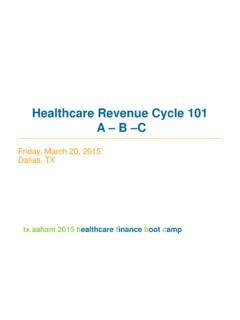Transcription of Miami-Dade County's Urban Development Boundary: A …
1 Miami-Dade County's Urban Development boundary : a case study Issues and Reality Joseph G. Goldstein Holland & Knight LLP. I. Urban Development boundary (UDB) / Urban Expansion Area (UEA). A. Early Urban Service boundary B. UDB - Comprehensive Development Master Plan (CDMP), Page I-57. Urban Development boundary The Urban Development boundary (UDB) is included on the LUP map to distinguish the area where Urban Development may occur through the year 2015from areas where it should not occur. Development orders permitting Urban Development will generally be approved within the UDB at some time through the year 2015 provided that level-of-service standards for necessary public facilities will be met. Adequate countywide Development capacity will be maintained within the UDB by increasing Development densities or intensities inside the UDB, or by expanding the UDB, when the need for such change is determined to be necessary through the Plan review and amendment process.
2 The CDMP seeks to facilitate the necessary service improvements within the UDB to accommodate the land uses indicated on the LUP map within the year 2015 time frame. Accordingly, public expenditures for Urban service and infrastructure improvements shall be focused on the area within the UDB, and Urban infrastructure is discouraged outside the UDB. In particular, the construction of new roads, or the extension, widening and paving of existing arterial or collector roadways to serve areas outside the UDB at public expense will be permitted only if such roadways are shown on the LUP map and in the Transportation Element. The entire unincorporated area within the UDB is eligible to receive and utilize Severable Use Rights (SURs) in accordance with provisions of Chapter 33-B, Code of Miami-Dade county . Accordingly, certain developments as specified in Chapter 33-B may be entitled to density or floor area bonuses as authorized by Chapter 33-B.
3 If the existing SUR program is modified pursuant to Land Use Element Policy LU-9 Cor other transferable Development rights programs are established, all rights established by such programs shall be transferable to receiver sites inside the UDB as established in those programs. No new commercial agricultural use of property may be established within the Urban Development boundary , except on property designated agriculture on the LUP map or zoned AU (Agricultural) or GU (Interim). All property within the Urban Development boundary not designated Agriculture or zoned AU or GU. shall not be permitted to be used for the establishment of any new commercial agricultural use. An additional exception is that land in utility easements or rights-of- way or airport or other large government -owned properties may be approved for new commercial agricultural uses where the use would be compatible with, and would have no unfavorable effect on, the surrounding area.
4 Commercial agricultural uses include, without limitation, all uses of property associated with commercial horticulture; floriculture; viticulture; forestry; dairy;. livestock; poultry; apiculture; pisciculture, when the property is used principally for the production of tropical fish; all forms of farm production; and all other such uses, except retail nurseries and retail greenhouses. Incidental agricultural use of property specifically authorized by zoning which is otherwise consistent with the LUP map does not constitute commercial agriculture use within the meaning of this provision. C. UEA CDMP, Page I-58. Urban Expansion Area The Land Use Plan map also contains a year 2025 Urban Expansion Area (UEA) boundary . The UEA is comprised of that area located between the 2015. UDB and the 2025 UEA boundary . The Urban Expansion Area is the area where current projections indicate that further Urban Development beyond the 2015 UDB is likely to be warranted some time between the year 2015 and 2025.
5 Until these areas are brought within the year 2015 UDB through the Plan review and amendment process, they are allowed to be used in a manner consistent with the provisions set forth for lands designated as "Agriculture" or the applicable "Open Land" area. Urban infrastructure and services should be planned for eventual extension into the UEA, sometime between the years 2015 and 2025. However, if water or sewer lines or major roadway improvements are extended beyond the UEA in order to serve a necessary public facility that has been approved consistent with the Comprehensive Development Master Plan, these improvements should be sized or restricted to accommodate only the needs of the public facility. D. Jurisdiction Section , Miami-Dade county Code Sec. Applicability of Comprehensive Master Plan to Municipalities. (a) The location of the Urban Development boundary (UDB) and permitted land uses outside the UDB shall be governed by the Miami-Dade county comprehensive Development Master Plan (CDMP) notwithstanding the fact that the UDB may lie within a municipality.
6 (b) Any amendments to the UDB line or land uses permitted by the CDMP shall be filed and processed in accordance with procedures for applications located within the unincorporated area. (c) All municipal land use decisions outside the UDB line shall be consistent with the CDMP. II. History of the UDB1. A. When was it established? 1. 1975 - Implied through Land Use Plan map and policies (Exhibit A). 1. Source: Miami-Dade county Department of Planning and Zoning 2. 1983 - UDB was first denoted by an explicit line on the land use plan map (Exhibit B). a. Urban land use and service policies referred to the delineated line;. b. The best Agriculture land was distinguished from less suitable Open Land on the LUP map; and c. Stronger agricultural land use preferences policies were added for the area delineated as Agriculture.. 3. 1988 Current Plan, Implementing 1985 Growth Management Act 3. Current Map (Exhibit C). a. Miami-Dade county Total Land Area 1,965 sq.
7 Miles b. National and State Preserves 800 sq. miles c. Land Currently Inside UDB 418 sq. miles B. Land added to UDB over time (Exhibit D). 1. 1976-1980: sq. miles 2. 1981-1987: sq. miles 3. 1988 Update: sq. miles 4. 1989-1995: sq. miles 5. 1995-2005: sq. miles 6. 2006-2007: sq. miles III. Expanding the UDB. A. The Urban Expansion Area - Impact B. Comprehensive Plan Requirements 1. State Comprehensive Plan Chapter 187, Florida Statutes / Rule 9J-5, a. Sprawl Rule (5), Florida Administrative Code (5) Review of Plans and Plan Amendments for Discouraging the Proliferation of Urban Sprawl. (a) Purpose. The purpose of this subsection is to give guidance to local governments and other interested parties about how to make sure that plans and plan amendments are consistent with relevant provisions of the state comprehensive plan, regional policy plans, Chapter 163, Part II, , and the remainder of this chapter regarding discouraging Urban sprawl, including provisions concerning the efficiency of land use, the efficient provision of public facilities and services, the separation of Urban and rural land uses, and the protection of agriculture and natural resources.
8 (b) Determination. The determination of whether a plan or plan amendment discourages the proliferation of Urban sprawl shall be based upon the standards contained in this subsection. (c) In general. The discouragement of Urban sprawl accomplishes many related planning objectives. The purpose of this subsection is to provide a general methodology for examining whether or not a plan or plan amendment discourages the proliferation of Urban sprawl. This subsection is organized into twelve paragraphs, paragraphs (5)(a) through (5)(l). Nothing in this paragraph (5) shall be interpreted to require that a local government submit information beyond the information required by other provisions of this chapter. (d) Use of indicators. Paragraph (5)(g) describes those aspects or attributes of a plan or plan amendment which, when present, indicate that the plan or plan amendment may fail to discourage Urban sprawl. For purposes of reviewing the plan for discouragement of Urban sprawl, an evaluation shall be made whether any of these indicators is present in a plan or plan amendment.
9 If an indicator is present, the extent, amount or frequency of that indicator shall be considered. The presence and potential effects of multiple indicators shall be considered to determine whether they collectively reflect a failure to discourage Urban sprawl. (e) Methodology for determining indicators. Paragraphs (5)(h) through (5)(j). describe the three major components of a methodology to determine the presence of Urban sprawl indicators. Paragraph (5)(h) describes how land use aspects of a plan shall be analyzed. The land use element, including both the future land use map and associated objectives and policies, represents the focal point of the local government's planning effort. Paragraph (5)(i) describes the unique features and characteristics of each jurisdiction which provide the context of the analysis and which are needed to evaluate the extent, amount or frequency of an indicator and the significance of an indicator for a specific jurisdiction.
10 Paragraph (5)(j) recognizes that land use plans generally may be significantly affected by other Development policies in a plan which may serve to mitigate the presence of Urban sprawl indicators based on the land use plan alone. Paragraph (5)(j) describes Development controls which may be used by a local government to mitigate the presence of sprawl. (f) Analysis components. subsection (5)(k) describes how the analysis components described in subsections (5)(h) through (5)(j) are combined in a systematic way to determine the presence of Urban sprawl indicators. (g) Primary indicators. The primary indicators that a plan or plan amendment does not discourage the proliferation of Urban sprawl are listed below. The evaluation of the presence of these indicators shall consist of an analysis of the plan or plan amendment within the context of features and characteristics unique to each locality in order to determine whether the plan or plan amendment: 1.






